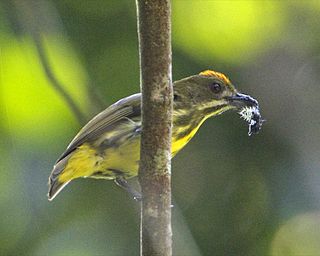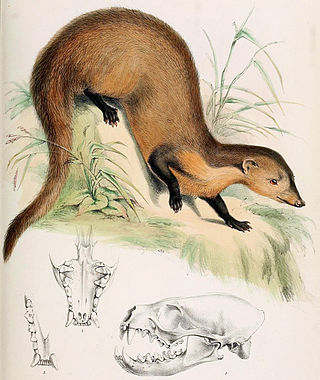
The Nilgiri flowerpecker is a tiny bird in the flowerpecker family. Formerly a subspecies of what used to be termed as the plain flowerpecker although that name is now reserved for Dicaeum minullum. Like others of the group, it feeds predominantly on nectar and fruits. They forage within the canopy of forests and are found in India. They are non-migratory and the widespread distribution range includes several populations that are non-overlapping and morphologically distinct, some of which are recognized as full species. They are important pollinators and dispersers of mistletoes in forests.

Dicaeum is a genus of birds in the flowerpecker family Dicaeidae, a group of passerines tropical southern Asia and Australasia from India east to the Philippines and south to Australia. The genus Dicaeum is closely related to the genus Prionochilus and forms a monophyletic group.

The thick-billed flowerpecker is a tiny bird in the flowerpecker group. They feed predominantly on fruits and are active birds that are mainly seen in the tops of trees in forests. It is a resident bird with a wide distribution across tropical southern Asia from India east to Indonesia and Timor with several populations recognized as subspecies some of which are sometimes treated as full species.

Legge's flowerpecker or the white-throated flowerpecker, is a small passerine bird. It is an endemic resident breeder in Sri Lanka. It is named after the Australian ornithologist William Vincent Legge.

The olive-crowned flowerpecker is a small passerine bird in the flowerpecker family, Dicaeidae. It is found in far western New Guinea and on adjacent islands.

The blue-eared barbet is a barbet in the Megalaimidae family native to mainland Southeast Asia. Because of its wide distribution and stable population it is listed as Least Concern on the IUCN Red List.

The ruby-cheeked sunbird is a species of sunbird in the family Nectariniidae.

The red-keeled flowerpecker or red-striped flowerpecker is a species of bird in the family Dicaeidae. It is endemic to the Philippines. Its natural habitat is subtropical or tropical moist lowland forests. The black-belted flowerpecker was formerly regarded as a subspecies of this bird.

The scarlet-backed flowerpecker is a species of passerine bird in the flowerpecker family Dicaeidae. Sexually dimorphic, the male has navy blue upperparts with a bright red streak down its back from its crown to its tail coverts, while the female and juvenile are predominantly olive green. It is found in subtropical or tropical moist lowland forests and occasionally gardens in a number of countries throughout South and East Asia.

The black-belted flowerpecker or Visayan flowerpecker, is a species of bird in the family Dicaeidae. It is endemic to the Philippines where it is restricted to Panay, Negros and Guimaras islands. It was formerly regarded as a subspecies of the more widespread red-keeled flowerpecker. Sometimes the name red-keeled flowerpecker is used for D. haematostictum and D. australe is then known as the red-sided flowerpecker.

The fire-breasted flowerpecker is a species of bird in the family Dicaeidae found in the Indian Subcontinent and Southeast Asia. Like other flowerpeckers, this tiny bird feeds on fruits and plays an important role in the dispersal of fruiting plants. Unlike many other species in the genus, this species has marked sexual dimorphism with the male having contrasting upper and lower parts with a distinctive bright orange breast patch. The female is dull coloured.

The black-sided flowerpecker, also known as the Bornean flowerpecker, is a species of bird in the family Dicaeidae. It is endemic to the island of Borneo, where it is found in the mountains, primarily above 1,000 m (3,300 ft) in elevation. The species is sexually dimorphic. The male has glossy blue-black upperparts, with a scarlet throat and breast, a dark grey upper belly, olive flanks, a white lower belly, and a buffy vent and undertail coverts. The female is olive-green above and greyish below, with buffy flanks and a whitish throat. It inhabits a range of forest habitats, including primary and secondary montane forest, kerangas forest, and scrub, and is also occasionally found in gardens. It feeds primarily on small fruits—particularly mistletoe berries—as well as seeds, nectar, and various invertebrates. It builds a nest of moss, camouflaged on the outside with lichens and lined with the pith of tree ferns. The International Union for Conservation of Nature rates it as a species of least concern. Though its numbers have not been quantified, the black-sided flowerpecker is said to be common throughout much of its range, and any declines are not thought to be precipitous. However, destruction of forest for palm plantations may impact it.

The whiskered flowerpecker is a species of bird in the family Dicaeidae. It is endemic to the island of Mindanao in the Philippines.

The Sunda forktail is a species of bird in the family Muscicapidae. It is endemic to Indonesia, where it is restricted to the islands of Java and Sumatra. Its natural habitat is boulder strewn streams in tropical moist montane forest from 600–2000 m. More rarely the species occurs closer to sea level. The species is common in Sumatra, but is rarer in Java, where the white-crowned forktail is more common.

The yellow-breasted flowerpecker is a species of bird in the family Dicaeidae. It is found in Brunei, Indonesia, Malaysia, Myanmar, Singapore, and Thailand. Its natural habitats are subtropical or tropical moist lowland forest and subtropical or tropical moist montane forest.

The blue nuthatch is a bird species in the nuthatch family Sittidae. It is a medium-sized nuthatch, measuring 13.5 cm (5.3 in) in length. The species, which shows slight sexual dimorphism, has dramatic coloration unlike any other member of its genus. Its head is black or blackish-blue dark blue upperparts close to purple with azure feathers. The wings are edged with black. The throat and chest are white or a washed buff color, contrasting with the upperparts and the belly of a very dark blue; the covert feathers are generally clear, blue-gray or purplish.

The collared mongoose is a mongoose species native to Borneo and Sumatra; its presence in the Philippines is uncertain. It is listed as Near Threatened on the IUCN Red List.
The pink-breasted flowerpecker is a species of bird in the family Dicaeidae that is native to the south and southeast Maluku Islands of Indonesia. It was formerly considered a subspecies of the mistletoebird.
The Cambodian flowerpecker is a species of bird in the family Dicaeidae that is native to east Thailand and Cambodia. It was formerly considered to be a subspecies of the fire-breasted flowerpecker.
The fire-throated flowerpecker is a species of bird in the flowerpecker family Dicaeidae that is found in the Philippines except on the islands of Mindoro, the Palawan group and the Sulu Archipelago. It was formerly considered to be a subspecies of the fire-breasted flowerpecker.

















